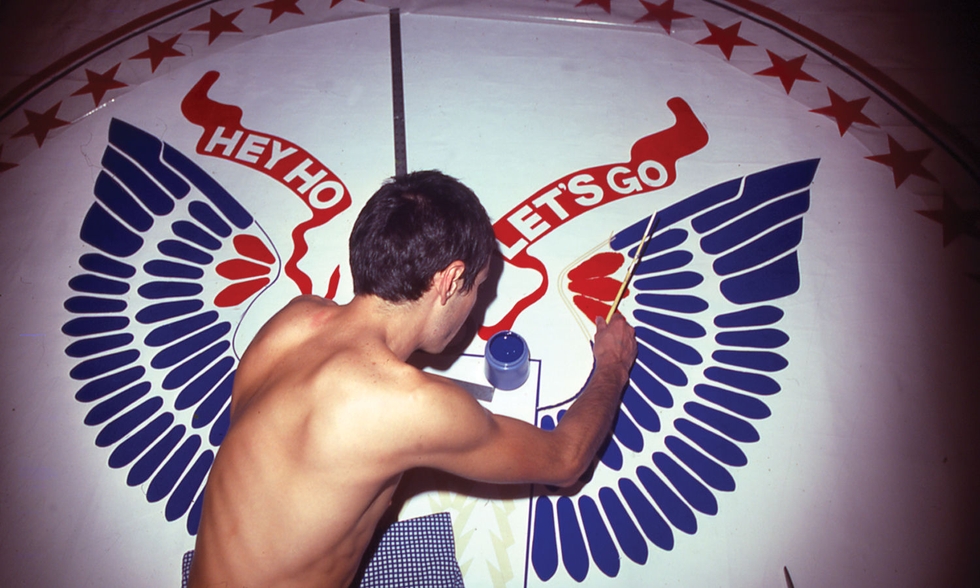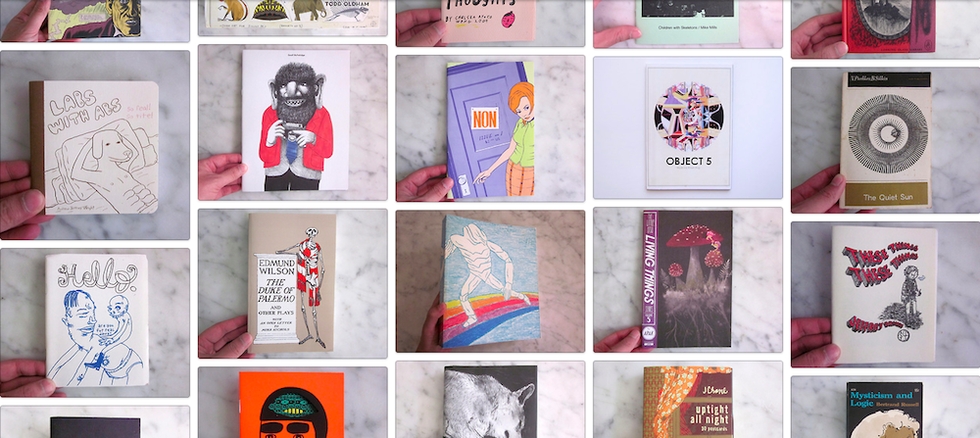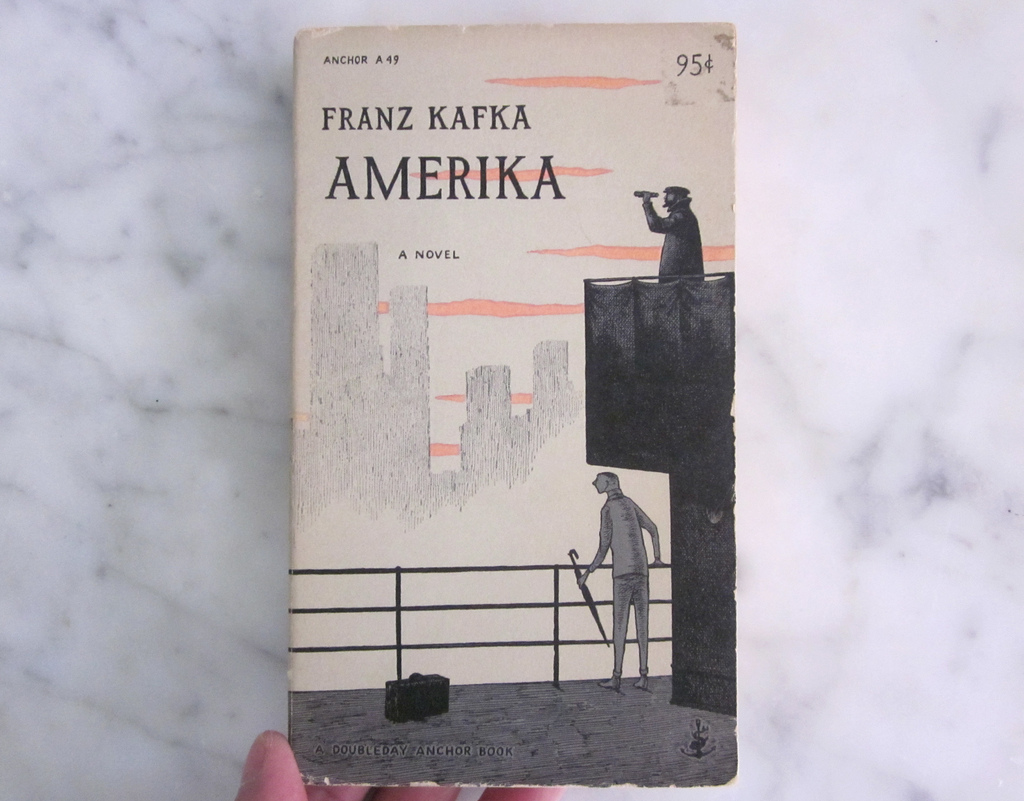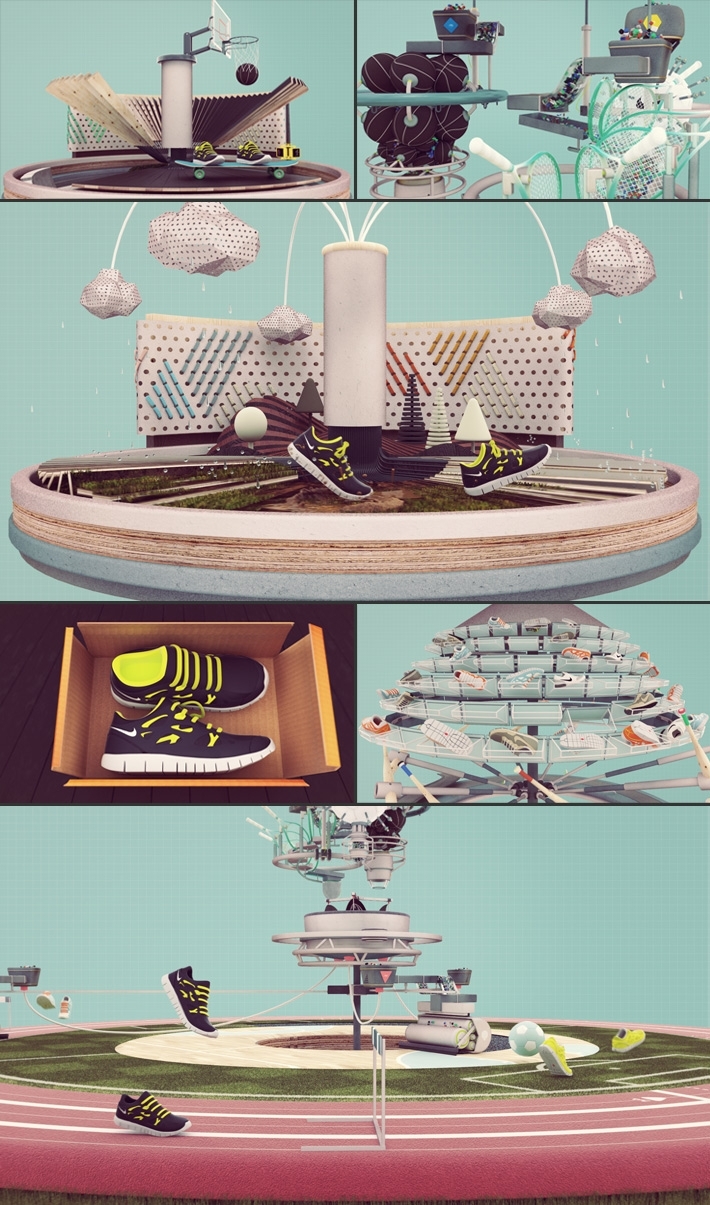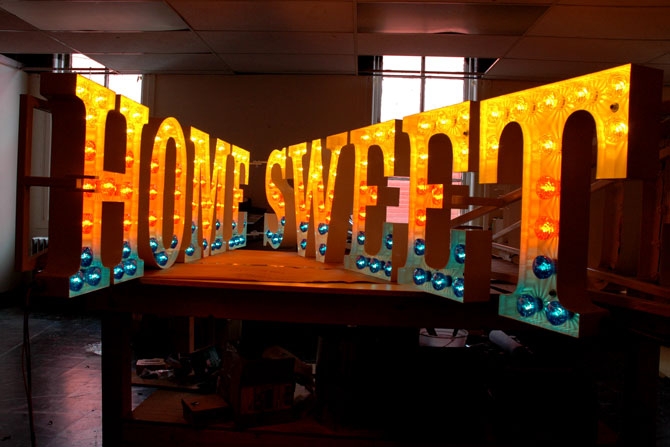The Ramones' long-term art director and lighting designer, Arturo Vega has died at the age of 65. Vega, who attended an impressive 2,263 Ramones performances, designed their patriotic crest logo after a visit to Washington, D.C. He replaced the arrows in the original Presidential seal with a more punk-friendly baseball bat, and added an apple tree branch in the eagles' left claw "since the Ramones were American as apple pie."
Rock historian Legs McNeil posted the following message on his Facebook:
"RIP: ARTURO VEGA: 1948-2013 Sleep gently my dear friend, you were the must optimistic, jubilant and fun pal anyone could wish for. I don’t know what the world will be like without, nor do I want to even imagine it… But I know you will find eternal happiness wherever you end up….I love you Arturo."
Images courtesy of Dexterity Press
Rodan was only active a few years, but the Louisville, KY-based band made quite an impression on the underground scene of the early '90s with powerful but precise compositions which played with extreme dynamics and time signatures. The band's music lurched like a goliath insect—and appropriately its album art for debut Rusty featured a butterfly in flight.
While guitarist/vocalist Jeff Mueller continued in bands such as June of 44 and Shipping News, he eventually focused on art and design, setting up his own printing press studio in Chicago—before moving to New Haven, CT—with his wife Kerri. Rodan's Jason Noble passed away in 2012, so tragically he won't see the release rarities album Fifteen Quiet Years, due out tomorrow, June 11, on Touch and Go/Quarterstick Records. Its cover features a cicada, which seems particularly apt for a band's work unearthed after so many years.
Nothing Major caught up with Mueller to find out more about his bug obsession, printing biz, and Fifteen Quiet Years.

I remember you were really into insects during the Rodan years—I mean visually. I think perhaps you had some bug art in your pace in the Rocket House, my memory can't be trusted.
That's true —there were also crayfish, bird and/or rat skeletons, cicadas, a small frog, one rhinoceros beetle, monarch butterflies, and an egyptian luna moth. All found in the "no longer alive" category, even the skeletons. After their capture, I would preserve them in glass collages using water-born polyurethane to hold the subject in between layers of cut glass. There would often be other small objects like a mono-ear piece or small rubber pig or paper mai-tai umbrella also included in the composition —these items, I think, would be included to give the deceased a source of entertainment, hopefully garnering a post-humous chortle.

What kind of things usually find their way into your printing over the years?
Lots of stuff: appropriated historic anatomical engravings, primates eating delicious iced cream cones, greyhound skeleton, lanterns, ornithological imagery (found, as well as Jeff-generated illustrations), wood, upside-down/foot-up pied metal type, old and new song lyrics, various patterns built using Adobe Illustrator, etc.

What's Dexterity Press and how long have you been doing it? Is is your main gig?
What kind of printing equipment are you using? Where is your studio?
Dexterity Press is a letterpress printing studio my wife Kerri and I opened 13 years ago. It's my main, 9-5 work these days - though that's only been the case since we moved east three years ago. Our first ten years in Chicago were always supplemented by other jobs—painting Chicago north-side houses with Dan Grzeca was key to keeping us alive while things were VERY slow in the early days at our shop. We are now located in New Haven, CT—in the old A.C. Gilbert building complex, where Erector Set toys used to be manufactured. We print on a Vandercook Universal 1 and a Chandler and Price 10 x 15 platen press.

You recently printed the Thrill Jockey 20th Anniversary posters. What else have you been working lately that's music related?
We printed an Allen Ginsberg/Arthur Russell 10" a year or so ago now for Presspop Gallery, Tokyo. We printed a compilation 12" called "Eight Trails, One Path" for Three Lobed Recordings last year—that was fun because Casey Burns did the art, and many great musicians were involved. We printed an insane looking Mick Barr 12" for the energetic New Haven label Safety Meeting Records. We printed matchbook-style CD jackets for Christian Frederickson. We've been reprinting and retro-fitting Rachel's and June of 44 CD/LP jackets for Touch and Go/Quarterstick records, trying to figure out special-packaging manufacturing methods that can be done entirely in-house for less cost. We printed LP/CD jackets for a great Louisville band called Coliseum. Most recently, the Rodan record took over our studio for a couple weeks.

What was your involvement in the design of the new Rodan rarities album Fifteen Quiet Years?
Jason and I talked about grabbing graphic bits and pieces from our previous releases and collaging them into the new record design; the nuts and bolts of the art was already done, it just needed to be messed with and changed-up some. I did the new layout and created the cicada on the cover. The Quarterstick staff (Corey Rusk, April Sims, Adam Reach, and David Babbitt) helped proof-read and assisted immensely with pre-press. (Rodan members) Tara (Jane O' Neil) and Kevin (Coultas) kicked in with motivational speak and congenial/positive attitudes, sweet love.
Contact Dexterity Press, or browse the Dexterity Press Etsy shop.
If you put aside your hang-ups about the morbid pleasure of pouring red wine from an object that treats it like blood and you like a thirsty vampire, Etienne Meneau's Strange Decanters are a beautiful line of glassware. Instead of the short pitcher form, the Strange Decanter comes in two equally gruesome varieties, the heart line which includes "small heart" and "big heart," each with numbered vein systems. For the days that aren't Halloween, you could always say it's meant to be tree roots. [via]
Etienne Meneau makes each carafe by hand, in extremely limited runs.



A book club worth its salt should turn one onto something one otherwise wouldn't have found. While the volumes posted to the Visual Book Club are limited to a cover and a few images, and the discussions consist simply of likes and reblogs, the Tumblr has the same curatorial spirit. The posts lean heavily toward zines and comics, but every once in a while something like a vintage Kafka paperback makes an appearance.
Follow Visual Book Club on Tumblr for some new zines in your dashboard.
Between the elegance of Moleskine and the ruggedness of Field Notes, there are literally reams of bound paper out there to save your brilliant thoughts and sketch world-changing ideas. But what if a notebook, a tool of the creative class, actually sparked creativity? Chicago artist and toy designer Shawn Smith’s Resketch project, currently on Kickstarter, not only records but elicits ideas from users with a series of creative prompts, pages with images, characters and creative inspiration sandwiched between multi-colored, multi-textured stacks of resourced paper. “As far as we’ve come with digital media, it’s still not as direct as pencil, pen, and paper,” says Smith. These sleek, environmentally friendly tomes manage to foster the sense of discovery that might lead one to furiously scribble inside a notebook in the first place.
Resketch books (7 x 9-inch, between 85-100 pages, and coil-bound with a thick chipboard cover and back) are currently available on Kickstarter; backers can also opt for the Artist Cover series, featuring prints from Art Baltazar, Andrew Bell, Chris Ryniak, Mig Reyes, and Smith.
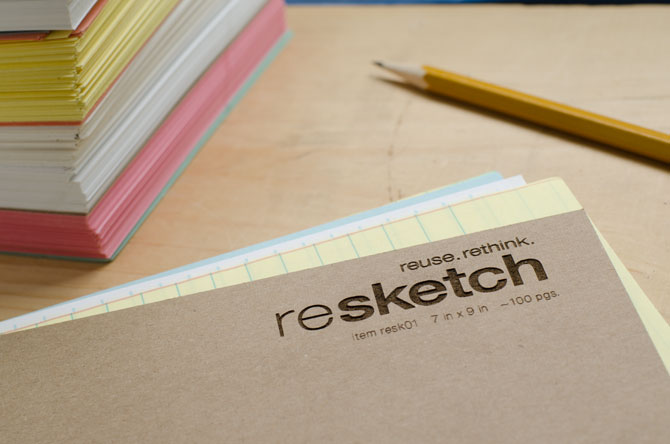

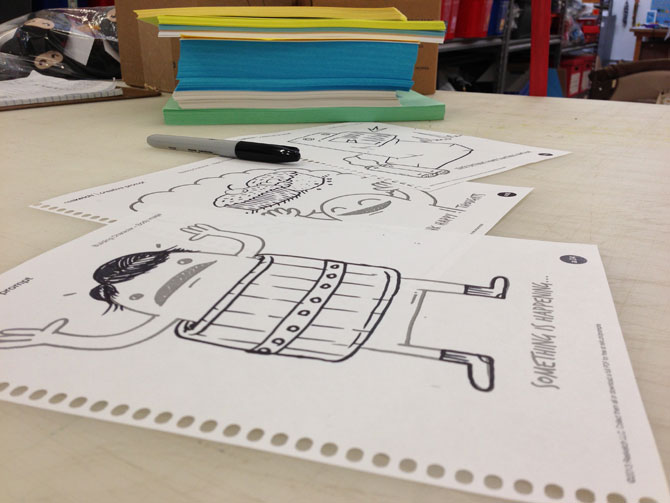

To promote the brand's 23-year-old Reuse-a-Shoe recycling program, Nike teamed with ManvsMachine to create an impressive motion graphics spot that shows the lifespan of a pair of Nike sneakers through up to their eventual recycling. Playing on the "sole" and "soul" pun, the clip features a kind of whimsical recycling machine that uses baseball bats, tennis rackets, and basketballs to turn used Nike sneakers into Nike Grind, a field building material. [via It's Nice That]
Curated by Gregory Tom of Eastern Michigan University, the exhibition includes work from Jason J. Ferguson, Matt Kenyon and Osman Khan. The artists play with typical elements found in an American home; a table and chairs, a houseplant, or a beam, and alter them to express ideas about faith, the mortgage crisis, and the American family.
The exhibit ties into "Mobile Homestead," a permanent artwork by the late Mike Kelley located on the grounds of MOCAD and based on the artist's childhood home in Westland, a neighborhood which primarily housed many workers for the Big Three auto makers.
The Museum of Contemporary Art Detroit (MOCAD) presents (in)Habitation on Friday, June 7, 2013. The exhibition runs through July 28, 2013. There's an opening party tonight, June 7, with a live set from Illy Mack, $5 at 7pm.
 Matt Kenyon, Spore
Matt Kenyon, Spore Osman Khan, House
Osman Khan, House
Justin Porcano, the product designer behind Wallhub, was in a brainstorming session when he realized the light switch plate was an incredibly underused structure. So he gave the switch plate a second functional purpose by adding simple hooks for things we grab on the way out of the house, like keys, mail, and umbrellas. And best of all, because the Wallhub is built to fit on a standard switch plate, there's no additional wall damage from hooks or other hangers.
The Wallhub comes in three styles to fit most light switches.


In recent years, we've seen many unsung or short-lived indie and punk acts of the '90s get new Internet-age respect, with online interest plus reissues and reunions feeding the fire. Universal Order of Armageddon, an East Coast post-hardcore act from the early '90s, for example, reunited in 2011 for a series of gigs and a Chaos in Tejas festival set. Yesterday, however, the band realized it was getting attention of a different kind when guitarist Tonie Joy was informed that a live performance photo of UOA had been used in a Jack Daniel's ad in the UK. Joy shared the image on his Facebook page where NoMa heard about it. Joy declined to comment on the situation. We're simply left wondering how it happened and if perhaps, this is one among many appropriations to come from the '90s—a cultural era that has a surprisingly high level of cachet at the moment.
A classic vinyl record spinning on a handsome vintage turntable conjures all kinds of memories—often of the first time we heard the music itself. German photographer Kai Schäfer plays with these memories and associations in his "World Records" series. He began shooting Led Zeppelin IV a few years back, and has since shot more than a hundred records (from London Calling to Harvest) on more than 25 different vintage turntables (Dual, Braun, B&O).
Wired reports that Schäfer uses a Hasselblad camera with a Phase One digital back and a special flash, then makes enormous prints that can be six feet wide. His rules for the records? First or second pressings from the artist's native country shot on a turntable that would have been similar to one available at the time of the record's release. He often rents the vinyl or turntables for audiophiles in Düsseldorf, but has popped for collectables, such as a $650 copy of Elvis's "Mystery Train" single on Sun.






